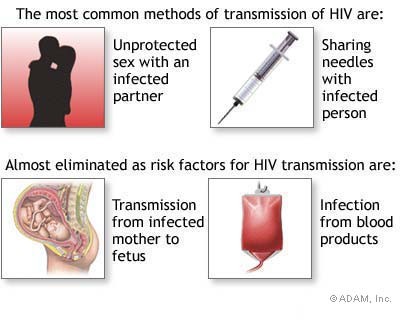
Contents
HIV Infection Facts, History and Causes
HIV-1 and HIV-2 are the two types of HIV. HIV-1 is the primary cause of HIV infection and AIDS worldwide, while HIV-2 is limited to parts of West Africa and less easily transmitted.
The human immunodeficiency virus (HIV) is a retrovirus that causes HIV infection and acquired immunodeficiency syndrome (AIDS). Once someone acquires the virus, it attaches to and enters human cells, especially CD4 T-cells, macrophages, and dendritic cells. The virus contains RNA, which it transcribes into DNA using reverse transcriptase. The resulting DNA integrates into the human genome, fooling the genome into making more copies of the virus. Infected cells produce and release trillions of new HIV viruses every day, infecting more and more cells.
Even 1 milliliter of blood can contain over 1 million copies of the virus during peak viral reproduction. The virus’s surface proteins constantly change, making it difficult for the body to detect and kill the invaders. Additionally, the viruses may develop mutations that make them resistant to treatments. Some areas of the body, such as sex organs and the brain, are more difficult to reach with medications, serving as persistent reservoirs of the virus. While HIV production can be controlled by treatment, there is currently no way to completely stop all virus production until infected cells are replaced with healthy ones.
QUESTION
What is the history of HIV?
Scientists have shown that HIV-1 may have spread to humans over 100 years ago through primate-to-human transmission. Chimpanzees are the most likely source of HIV-1 transmission.
Isolated human cases existed before HIV infection gained attention among physicians. HIV has been identified in preserved tissue from as early as 1959. The virus likely spread to Haiti and then to the United States in the late 1960s or early 1970s. Initially recognized in the gay male community, the virus began to spread among people with multiple sexual partners. Over time, individuals with HIV infection began to develop AIDS and die.
In 1981, the Centers for Disease Control and Prevention noted a cluster of pneumonia caused by Pneumocystis jirovecii (formerly known as Pneumocystis carinii) in young men. These individuals had depleted counts of CD-4 T cells. Further investigation revealed that gay men with multiple partners were most likely to have the disease, suggesting sexual activity as a key factor in transmission. The disease was later discovered in people injecting illicit drugs, heterosexuals with multiple sexual partners, people who received blood products, and babies born to infected mothers. HIV was identified as the likely cause of AIDS by Dr. Luc Montagnier in France and Dr. Robert Gallo in the United States. A test for HIV was developed and used for diagnosis and blood safety.
While some associate HIV with the gay male community, HIV does not discriminate based on class, gender, ethnicity, or sexual orientation. It can affect injection drug users, people engaging in high-risk sexual behaviors, and preventing HIV requires recognizing this.
What causes HIV infection?
Approximately 37 million people worldwide are HIV-infected. Sub-Saharan Africa bears the highest burden, with over 2 million new HIV infections as of 2014. Undiagnosed HIV infections contribute to continued transmission, including up to one-third of transmissions in the U.S. among individuals over 13 years old as of December 2012. An estimated 14% of these individuals were unaware of their infection. The South has the highest number of HIV+ cases per 100,000 people. In 2015, African-Americans accounted for nearly half of new HIV diagnoses, despite making up only 12% of the U.S. population. Hispanics, who constituted 18% of the population in 2015, experienced approximately one-quarter of new HIV diagnoses.
In 2015, MSM (men who have sex with men) accounted for 67% of all new HIV diagnoses. Heterosexual sex accounted for 24% of new cases, including 86% of newly infected women. Young people have an increasing risk of acquiring HIV, with young gay and bisexual men representing 84% of new HIV diagnoses in the 13-24 age group in 2015. Young African-Americans are heavily impacted in this group.
Only 6% of new HIV diagnoses were attributed to injection drug use (IVU), including 13% of women with new HIV infections.
What are risk factors for HIV infection?
The main modes of HIV transmission in the U.S. are anal and vaginal sexual intercourse, as well as sharing needles/syringes when using injected drugs. Risk factors for HIV infection include having non-monogamous sexual intercourse, having unprotected sex, or using injectable illicit drugs. Anal sex poses the highest risk for acquiring or transmitting HIV, especially for the receptive partner. Unprotected sex also increases the risk of other sexually transmitted infections (STIs), which can further enhance the risk of HIV infection. The risk of acquiring or transmitting HIV through oral sex, kissing, or touching is extremely low. However, other STIs are still possible. Transmission from an infected mother to an unborn child during pregnancy or delivery is also possible, which is why all pregnant women should be tested for HIV infection. While about 8,000 HIV-infected women give birth yearly, appropriate use of anti-HIV medications has reduced the risk of infection in newborns to 1% or less. Women attempting to become pregnant with HIV-infected male partners may take anti-HIV medications. Breastfeeding is not recommended for infected mothers in the United States due to the risk of transmitting HIV through breast milk. Other routes of transmission include accidental needle stick or sharps injuries in healthcare workers and splashes of contaminated material onto mucous membranes or nonintact skin. The risk of acquiring HIV infection from a blood transfusion in the United States is less than one in 1.5 million. Casual contact, such as shaking hands or sharing items, does not pose a threat of HIV infection.
By clicking Submit, I agree to the MedicineNet’s Terms & Conditions & Privacy Policy and understand that I may opt-out at any time.


